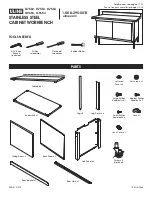
the application software. See the host application software user guide for instructions on configuring
the block size.
Updating the driver without rebooting
Procedure
The advanced path failover driver may be updated without rebooting the system by first removing the
existing drivers and then loading the new version. Verify that no applications have devices open that are
using the advanced path failover drivers and then use
rpm -U <filename>.rpm
to update the drivers.
See the release notes for specific file names.
Device files
The advanced path failover driver will resolve all paths to a device into a single ‘sg’ and ‘st’ entry in
the
/dev
directory for each device. Requests to open or send commands to that device path will use the
path selected by the advanced path failover driver. Alternate paths that address devices that are already
known are entered into an internal alternate path list and device files are not created for those paths.
Load balancing options for multiple tape drives
The driver balances the number of tape drives using each HBA at the same time in an attempt to improve
throughput to multiple tape drives. The level of path switching activity is adjustable.
The driver supports three levels of load balancing aggressiveness:
• Full Balancing — the most aggressive form of load balancing, which can result in frequent library path
failure alerts on a busy system when using multiple drives with multiple HBAs.
• Less Balancing — the least aggressive form of load balancing, which does some load balancing while
minimizing library path failure alerts. This is the default when the server is booted.
• No load balancing — load balancing is not a factor when assigning a drive to an HBA.
Common characteristics of both load balancing algorithms
The driver will attempt to balance the load each time a device file is opened to a tape device. The normal
on-the-fly path failover algorithms will not take other tape drive usage of an HBA into consideration. The
usage of the paths will only be evaluated at the next open of the device file.
The path will not be changed to a different path if another thread is holding the
/dev
file open. If multiple
threads have the
/dev
file open, the driver will not interfere with the path selection that has been made
by another thread.
The load balancing algorithms do not take path speed into consideration when selecting a path, they only
attempt to select a sparsely used HBA when a new
/dev
file to a tape drive is opened. This method does
not operate during data transfers, only at device file open.
If the load balancing algorithm is unable to select an appropriate path, the path selection algorithm reverts
to previous techniques.
If a ‘preferred’ path is set, this selection takes priority over the load balancing method. See
Updating the driver without rebooting
53
















































